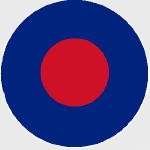Corgi AA32714 RAF Hawker Hunter T7 Training Aircraft - No. 237 OCU, RAF Honnington, England, July 1987 (1:72 Scale)
"In the future, war will be waged essentially against the unarmed populations of the cities and great industrial centers."
- Italian General Giulio Douhet
 The Hawker Hunter was a UK jet fighter aircraft of the 1950s and 1960s. The Hunter served for many years with the Royal Air Force and was widely exported, serving with 19 air forces. A total of 1,972 Hunters were produced by Hawker Siddeley and under licence.
The Hawker Hunter was a UK jet fighter aircraft of the 1950s and 1960s. The Hunter served for many years with the Royal Air Force and was widely exported, serving with 19 air forces. A total of 1,972 Hunters were produced by Hawker Siddeley and under licence.
The origins of the Hunter trace back to the Hawker Sea Hawk straight-wing carrier-based fighter. Seeking better performance and fulfillment of the Air Ministry Specification E.38/46, Hawker Aircraft's chief designer Sydney Camm created the Hawker P.1052, which was essentially a Sea Hawk with a 35-degree swept wing. First flying in 1948, the P.1052 demonstrated good performance but did not warrant further development into a production aircraft. As a private venture, Hawker converted the second P.1052 prototype into the Hawker P.1081 with swept tailplanes and revised fuselage, with a single jet exhaust at the rear. First flying on 19 June 1950, the P.1081 was promising enough to draw interest from the Royal Australian Air Force but development went no further and the sole prototype was lost in a crash in 1951.
Meanwhile, in 1946, the Air Ministry issued Specification F.43/46 for a daytime jet-powered interceptor. Camm took the basic P.1052 design and adapted it for the upcoming Rolls-Royce Avon turbojet. The Avon's major advantage over the Rolls-Royce Nene, used in the Sea Hawk, was the axial compressor, which resulted in a much smaller engine diameter and better thrust. In March 1948, the Air Ministry issued Specification F.3/48, to cover development of the project. Initially fitted with a single air intake in the nose and a T-tail, the project rapidly evolved to the more familiar shape. The intakes were moved to the wing roots, to make room for weapons and radar in the nose. A more conventional tail arrangement was devised, as a result of stability concerns.
Pictured here is a 1:72 scale replica of a RAF Hawker Hunter T7 jet fighter that was attached to No. 237 OCU, then deployed to RAF Honnington, England, during July 1987.
Sold Out!
Dimensions:
Wingspan: 5-3/4 inches
Length: 7-3/4 inches
Release Date: February 2010
Historical Account: "Training Wheels" - Work on a 2 seat variant of the Hawker Hunter began in 1954, when a contract was issued for the manufacture of two prototypes. Designed by a team led by Sir Sydney Camm, the first of these aircraft flew on July 8th 1955 with Neville Duke at the controls.
Hawker Hunter trainers enjoyed a long career in RAF service and one of its key roles was in training crews for the Buccaneer strike aircraft. To assist with this, several Hunter T7 cockpits were fitted with the same instruments and controls as those in the Buccaneer.
The Hunter T7, XL573, was delivered to the Day Fighter Leaders School at West Raynham in July 1958. After duty with 229 OCU and 4FTS, in Feb 1980 it joined 237 OCU at Honington where, following the grounding of the Buccaneer fleet, its primary role was to keep the Buccaneer flight crews current.
XL573 served the RAF for almost 33 years before ending its military days at Lossiemouth in 1991.


